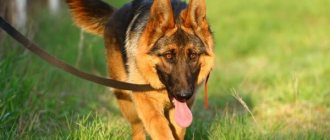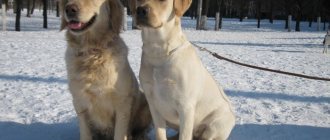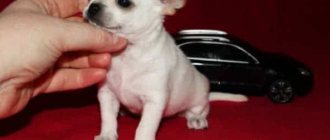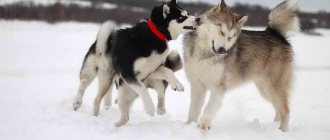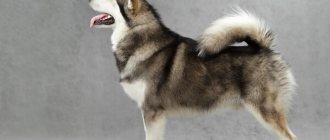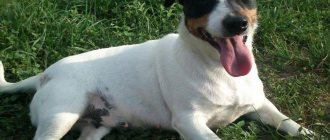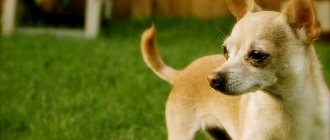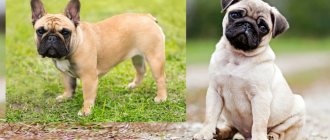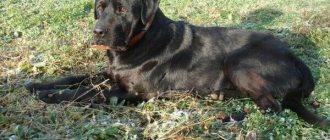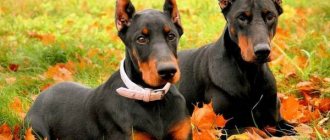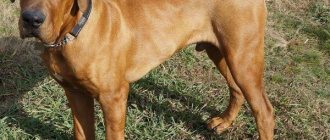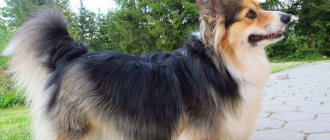Chihuahuas and Toy Terriers are breeds that have been popular for many years.
But despite their external similarity and small size, their features are completely different.
Only knowing this can you choose a dog that is completely suitable for yourself and your family.
But Chihuahuas and toy terriers are not as similar as they seem at first glance.
How do you choose?
Let's look into it in detail.
Description of the Chihuahua breed
Common parameters
There is no standard for Chihuahuas in the world.
Their maximum weight reaches 3 kg, minimum – 500 g . The normal figure is 2.-2.5 kg.
Breeders derived growth indicators proportional to weight. If a dog weighs less than 2 kg, its ideal height is 22-23 cm, if 2-3 kg, then 25 cm. Female Chihuahuas are slightly taller than males, and their short stature is especially valued.
Dogs have slightly apple-shaped heads and tall, wide ears that taper to a point. If the ears are not standing enough or not at all, this is considered a defect. Ear elevation in Chihuahua puppies occurs by three months.
Chihuahuas come in smooth-haired and long-haired varieties. The coat can be black, black and white, black and tan, chocolate, brindle and sable.
Pros and cons of Chihuahuas
Advantages:
- Consumes a small amount of feed;
- They have an affectionate and devoted character;
- Will not take up much space in the apartment;
- Suitable for small living space
- Do not require long walks or physical activity;
- They can go to the toilet and use the litter tray or diaper.
Flaws:
- Loud barking;
- Excessive fearlessness in front of large dogs;
- Excessive fragility;
- They treat children poorly;
- They don't remember commands well.
Character
Despite their small size, Chihuahuas have a fiery temperament, they are emotional, self-confident and overly brave, all this is manifested during walks and when communicating with other dogs. Training can correct their behavior.
Chihuahuas accept their brothers well; they are wary of representatives of other breeds..
They love their owner, but are more trusting of a woman than a man. They are also not very patient with children. Dogs do not tolerate rudeness or bad treatment; they may become offended or even bite.
It is noteworthy that long-haired Chihuahuas are more peaceful than short-haired ones . The latter are very hot-tempered.
Basics of caring for small dogs
Before deciding on a breed, you need to understand whether you can keep such a small dog. Most inexperienced owners believe that it is difficult to keep only large dogs, but this is far from the case! The smaller the pet, the greater the burden of responsibility you place on yourself.
Miniature dogs are more likely to get colds and are more susceptible to viruses and infections. In addition, almost all breeds have a fairly extensive list of hereditary ailments that can appear at any age. Four-legged animals are often injured in the most unexpected places; for example, one jump from a sofa can result in an open fracture of the front paw. There are many difficulties, but you can’t navigate them when you don’t know who to choose.
https://youtube.com/watch?v=h4SOMpIUUGc
Here are a few aspects that will help you understand whether you can handle caring for a small dog:
- Each room of the home should be equipped with a warm lounger with sides.
- After bathing, a small dog should not be exposed to drafts.
- There should be no surfaces in the home higher than 50 cm on which the pet can climb on its own.
- If you have small children in your family, they can unknowingly but significantly harm your pet. If you are looking for a dog for a child, make sure he is aware of it. Experts do not recommend having miniature dogs in families with children under 12 years of age.
- The eating area should be equipped with a non-slip mat.
- Small dogs often get cold, so your four-legged dog should have a wardrobe designed for autumn, spring and winter weather.
- In winter, small dogs need shoes.
- Miniature companions are very sociable and need to be taken with you everywhere.
- Socialization of babies lasts 2–3 years, and in its absence, the dog grows up fearful or aggressive.
- It is quite difficult to choose a balanced diet for a miniature dog, so most experienced owners advise purchasing high-quality industrial food.
- Pets are trained to use the tray, but, like all dogs, they need physical activity and games with their relatives.
- Males of miniature breeds are more finicky and obstinate than females. Girls are jealous and demanding.
- The dog should not be physically punished!
- Any miniature ward needs an owner-leader.
- The smaller the dog, the worse it tolerates anesthesia and aggressive treatment.
The list can be continued, but the essence is clear. The difference between a Chihuahua and a Toy Terrier is not that important if you are not willing to change your lifestyle and keep your pet safe. Are you not afraid of difficulties? Then let's continue - comparison of Toy Terrier and Chihuahua, who is better?
Description of Toy Terriers
Common parameters
Toy terriers are not very tall. Their height at the withers usually does not exceed 28 cm, and their weight is 3 kg.
There are long-haired and short-haired toy terriers . In long-haired animals, the fur coat reaches 5 cm, and there are feathers on the ears and limbs. Shorthairs have no undercoat, their coat is short and dense.
The dog has a dry oval body, the back is tense and falls towards the tail. The withers are clearly defined. Toys have their tail docked, but this procedure can be abandoned.
According to the standards, a purebred toy terrier must have the following parameters:
- Medium width oval chest;
- Convex skull with a round frontal part;
- Pointed muzzle and thin cheeks;
- Small nose, colored or black;
- Scissor bite;
- Lips tightly closed along the entire length.
- The eyes are large and slightly protruding, dark in color;
- Large erect triangular ears;
- High-set graceful neck;
- Thin, lean belly;
- Slender and straight legs;
- Oval paws, hind legs set slightly wider than front ones.
Toy Terriers were originally black and tan or brown and tan.
Now blue and tan, red with or without black or brown patina are also allowed . The color of the coat should be rich.
Advantages and disadvantages
Advantages of the breed:
- Cute appearance;
- Small size is suitable for keeping in small apartments;
- Little food required;
- Gets along easily with animals and children;
- It is easy to move long distances and travel with a dog.
Disadvantages of the breed:
- Increased bone fragility;
- Difficulty in diagnosing diseases;
- May be injured during a walk in clashes with other animals or people;
- Requires additional attributes for walking and increased attention.
There are two varieties of the Toy Terrier breed: Russian and English.
Character
The Toy Terrier is a very smart dog . Training him is not difficult.
At the same time, he is absolutely non-aggressive, friendly and peaceful. It also has such traits as courage, activity and the ability to always come to the owner’s defense.
He can become a good guard: his ringing bark and loud hearing allow him to notify about something that has happened..
But small sizes prevent you from realizing your full potential.
The dog will get along well with a child - toy terriers love to play . They behave calmly on the street, in public transport.
Dogs quickly become attached to people, love attention and do not like to be left alone. But you still need to be attentive to him, sometimes strict. This way you will prevent damage to property and furniture.
Mixed breed with [anchor href=»ZooDoma.com/sobaki/malenkie-porody/pomeranskij-shpits»]Spitz[/anchor]
Most often, to obtain original Yorkie puppies, they are bred with Spitz dogs. Puppies born as a result of such mating inherit the best qualities of both parents and have an attractive appearance and good health. Such dogs are not prone to developing genetic pathologies and, according to experienced breeders, are characterized by a high rate of survival.
Mestizos also have the following positive qualities:
- friendliness;
- intelligence and intelligence;
- loyalty;
- cheerful character;
- ability to learn;
- lack of aggression;
- empathy.
Here are some typical photos.
Each puppy has a unique set of characteristics, so it is impossible to predict the length, color or texture of the coat. It is also impossible to judge in advance the character of the future pet, but if any undesirable traits appear, they can be easily corrected with proper upbringing, training and socialization. The only thing we can talk about with confidence is the size of the mestizos. Adults do not grow large; they have a compact, less often medium size.
Caring for the hair of a Yorkie-Spitz crossbreed is primarily aimed at regular brushing to avoid the formation of tangles and monthly cutting of split ends of hair that impede normal coat growth.
How is a toy terrier different from a chihuahua?
Despite the fact that the dogs are similar to each other in appearance, they have a number of distinctive features (the pets are shown in the photo):
- Dogs have different origins;
- Toy Terriers are slightly larger than Chihuahuas;
- Toys have longer legs, Chihuahuas are squat;
- Toy terriers are more aggressive, protecting their owner, but they treat children much better than chihuahuas.
- Terriers are better trained;
- Shorthaired Toys do not have an undercoat, unlike Chihuahuas;
- A Chihuahua can be of any color; for a toy, the color is regulated by a standard.
Although Toys and Chihuahuas come in long-haired and smooth-haired varieties, the length of their coats also varies.
Exterior comparison: all about external similarities and differences
At first glance, the dogs are similar in appearance - compact sizes, large ears and eyes, and a sharp nose. Both Chihuahuas and Toys come in both short-haired and long-haired varieties.
Toychiki
However, upon closer examination, it is clearly visible that the dogs are completely different - the differences in exterior are significant.
With a relatively identical weight standard (up to 3 kg), there is a difference in constitution: the toy terrier has an asthenic build, a short body, long legs and neck. Until recently, toyams had their tails docked.
The elongated muzzle of the toy terrier with a movable nose button, expressive huge eyes and ears resembles the muzzle of a hedgehog.
Chihuahua
Chihuahuas are stocky, with a powerful chest and neck. The elongated body, compared to that one, rests confidently on low, strong legs.
The Chihuahua's head is more massive due to the structure of the skull; the snub nose is much shorter than that of the Toy.
The Chihuahua breed line, in addition to differences in coat length, is conventionally divided into two types - deer and cobby. Thin, light-built sneezes of the “dir” (deer) type are more similar in appearance to toychiks than the stocky “cobbies”.
Which breed is best for keeping in an apartment?
Dogs have different temperaments, so their behavior even in the house may differ.
Toy terriers are more cheerful and active. They won't let you get bored and will cheer you up, but their activity can be annoying. Chihuahuas are more reserved.
They can lie for a long time, just watching what is happening, waiting for the owner to call them . Here the character of the owner himself also plays a role - only he can decide what kind of dog will suit him.
Otherwise the dogs are similar. They eat little, but you need to protect them from high objects and falls. They require the same amount of attention, but Toys are easier to train than Chihuahuas.
Overall, these dogs are equally suitable for apartment living. How they behave depends only on the owner .
Expert opinion
Kozhevin Semyon Kirillovich
Expert dog handler.
“In general, these are, of course, different breeds. It is impossible to say unequivocally who is better, but subjectively, I would choose the toy terrier because they are more active. And I don’t sit in one place either. Chihuahuas are passive for me, but for older people they are ideal, for example.”
Which breed is the easiest to keep?
Both breeds are equally easy to care for and maintain.
The Toy Terrier is characterized by the longest list of hereditary diseases and diseases to which this breed is susceptible. Therefore, it requires a little more attention in order to consult a doctor at the first signs .
This can make your Toy Terrier more expensive to treat.
Otherwise, the dog requires the same things - brushing, rare bathing, clothing, ear cleaning and nail trimming, eye rubbing and the owner's affection and care..
Origin story
Each of these dogs has a rather interesting origin story.
History of the Chihuahua
The history of these small dogs begins in ancient times, when the Aztec and Mayan tribes lived. Back then, such dogs were considered a gift from the gods and guardians of the soul. The smallest dogs, which were considered priceless, were especially valued.
During the Spanish Conquest, a large number of representatives of this breed died. Restoration of the breed began only in the 19th century.
Origin of the Russian Terrier
Because of the October Revolution, Yorkshire terriers, which were popular among wealthy people, were almost completely destroyed.
In the fifties, breeders decided to start restoring toy terriers. The result was a cross between an English Terrier and other small dogs with a similar phenotype. Additional Information! The Russian breed received official recognition only in 2006.
Attitude towards children and pets
It has been said many times that Chihuahuas and Toy Terriers perceive children and other pets differently.
Chihuahuas are more jealous. He only accepts the owner, so he will not tolerate any other animal in the house besides him. Otherwise it will be subject to constant attacks.
A small dog will not lose its dignity. Also, their attitude towards children also causes caution.
Chihuahuas can tolerate games for a long time, and then simply bite or attack, because a child is smaller than an adult.
For this reason, this breed is not suitable for children, only those who already understand how to properly handle a dog so as not to harm it.
Toy terriers are completely opposite to chihuahuas in this regard. They can play with a child for hours, entertaining him, but this does not mean that the dog can be dragged by the ears and tail.
The Toy Terrier requires no less care when handling . Another thing is that he is more peaceful and friendly. He treats other pets the same way if they do not pose a threat to his owner.
What to consider when choosing?
When deciding which breed of dog you will take into your home, be guided by the following selection criteria.
Dimensions
Both dogs are miniature breeds. The difference in height and weight is not very large, however, the Chihuahua is recognized as the smallest decorative dog in the world. If your dream is a tiny pet that will fit in your jacket pocket or look cute out of a cup, then it is better to choose a Chihuahua. Among the toy terriers there are also tiny ones that barely reach 2 kg, but the primacy is assigned to the Chihuahua, since this breed has existed for a very long time.
Attitude towards children and other pets
Both dogs are quite friendly, but the Toy Terrier is more sociable and friendly. This dog will be friends with your child. The active puppy takes part in fun and noisy children's games with pleasure. If your child is reasonable and understands that it is impossible to offend animals, the heart of his little four-legged friend will belong to him forever.
The Toy Terrier is loyal to other pets in the house, but Chihuahuas are very jealous and do not like to share the shelter and love of their owners with anyone. These dogs do not like children and avoid them. If a child pesters an animal, the pet may bite him in response.
Nutrition
Proper feeding of dogs is the key to their health and excellent mood. There is no difference in feeding these breeds. For both pets, both a menu of natural products and dry food are suitable. The main thing is that the food is balanced and replenishes the dog’s energy expenditure.
The food must contain amino acids, vitamins, and minerals that ensure the proper functioning of the body. Ready-made food contains all the necessary elements and saves time. If you cook for your dog yourself, follow these rules.
- Don't give your dog food from your table. It contains salt, sugar, spices and food additives.
- Prepare food only from high-quality and fresh ingredients. To save money, do not give your pet food that has already begun to spoil.
- Serve dog dishes warm, but not hot or too cold.
If you adopted a puppy that was fed dry or wet food by its breeders, you can gradually switch it over to a diet of natural foods if you wish. It is not advisable to combine regular food with ready-made food. Pick one thing.
Chihuahuas and toy terriers are equally prone to allergies. Avoid giving dogs the following foods:
- chocolate;
- sweet cookies;
- brightly colored fruits: kiwi and strawberries;
- citrus fruits: oranges, tangerines, lemons;
- river fish;
- raw eggs.
- Be careful with chicken, it is also a strong allergen.
Of the dry foods, it is better to give preference to those that have the following composition:
- probiotics;
- vitamins;
- minerals;
- amino acids;
- multiple sources of carbohydrates and proteins;
- various fruits and vegetables.
If your dog eats dry food, be sure to fill his bowl with clean water every day. To determine the serving size, refer to the manufacturer's instructions. It is determined depending on the age and weight of the pet. Chihuahuas do not like dry food. To prevent your pet from being capricious, soak dry food in water.
Dogs are not very picky when it comes to keeping them. Short-haired animals generally do not cause any particular problems. Once a week they are combed out or walked through the fur with a special rubber glove. Long-haired dogs are brushed with a metal comb daily. Every day, pets wipe their eyes with a cotton pad moistened with boiled water or a decoction of chamomile.
Once a month, trim and polish the claws with a nail file, and clean the ears as necessary. Bathe animals with mild dog shampoo. It is advisable not to get the head wet; cotton swabs should be placed in the animal’s ears.
Walking with your pets may be less frequent than with regular dogs, especially in winter, when Toy Terriers and Chihuahuas may shiver from the cold. Dress them warmly. To prevent your pets from catching a cold in the cold, teach the animals to use a litter box or wear a diaper.
A place for the pet is organized where family members gather together. If he prefers to sit on a chair or sofa, organize a safe descent for him so that the dog does not fall and get injured.
Chihuahuas and toy terriers need training from early childhood. Which dog is more capable and remembers commands better is a controversial issue. Owners of toy terriers claim that their pet will easily understand the simplest commands and will carry them out. Chihuahua lovers say this about their pupils.
How a Chihuahua differs from a Toy Terrier, see the video below.
Who is more picky about feeding?
These breeds are susceptible to food allergies, so their nutrition requires attention and sometimes even painstaking selection of products.
At first, you will have to monitor how the dogs react to food in order to replace the allergic component if necessary.
They are also more suited to wet food than dry food . Granules can cause tartar in dogs and destroy protective enamel.
Comparison of breeds by other criteria
Toy terriers differ in coat type, Chihuahuas in physiological characteristics: cobby and dir.
Both dogs grow up by the age of one year, but if large breed puppies are three months old, then it is better to adopt a Chihuahua at 6-8 months. At this age, all defects, as well as their character, will already be noticeable.
IMPORTANT!
The life expectancy of Chihuahuas is longer than that of toy terriers - 14-18 years, and that of toys - 10-12.
Also, toy terriers quickly adapt to a new environment when moving. Chihuahuas need to be given attention so that they do not withdraw into themselves, become nervous and aggressive.
Both dogs do not tolerate loneliness well, both are loyal to their owners.
Toys are more active and show aggression towards strangers. Chihuahuas are calm in this regard; they react coldly and warily to new people.
Comparative characteristics
It’s worth starting with the basics, that is, with the origin of the breeds. The Russian Toy Terrier is the result of many years of work by breeders. English toys were brought to the territory of the USSR, and after that the state was under the “Iron Curtain”. Having no contact with the outside world, dog handlers continued to breed the English variety of the breed, but they did everything intuitively. When the Iron Curtain fell and Russian dog handlers gained access to the information, they discovered that they had developed a new breed. Russian and English Toys differ significantly, so the latter were recognized as a separate breed.
Note! Russian Toy Terriers differ only in their coat type. Chihuahuas are recognized in two physiological types - cobby and dir.
Chihuahuas came from Mexico, or rather, from its islands. It is impossible to establish their exact origin, but there are two main theories. According to one of them, Chihuahuas descended from Techichi, according to the second, they are close (or descendants) relatives of Chinese crested dogs.
Aboriginal representatives of the breed, like 15% of breeding dogs, have a soft spot or fontanel on their heads. Some experts consider the fontanelle a disadvantage, others, a breed trait. The second distinguishing feature is the shortened muzzle, the shape of which explains difficulty breathing and reverse sneezing. The characteristics of the Chihuahua are preserved from generation to generation.
Note! Toy Terriers and Chihuahuas can be either long-haired or short-haired. Naturally, dogs differ in appearance
Toy terriers are taller, slimmer and have a more elongated muzzle. The Chihuahua is more compact, with a large apple-shaped head and a short muzzle. Both breeds have erect ears and fairly long nails that require grooming.
Naturally, dogs differ in appearance. Toy terriers are taller, slimmer and have a more elongated muzzle. The Chihuahua is more compact, with a large apple-shaped head and a short muzzle. Both breeds have erect ears and fairly long nails that require grooming.
Important! Beware of breeders who sell too many puppies or guarantee mini sizes. Puppies of both breeds are very small and fragile
Usually, Chihuahua litters contain babies with different temperaments, and Toy Terriers are mostly choleric. In both breeds there is an unspoken division into standard and mini types. If we are talking about Russian Toy Terriers, then there can be no question of division; the standard clearly stipulates the dimensions of adult dogs. Chihuahuas are actually divided into two types, with mini being dogs weighing less than 1.8 kg
Puppies of both breeds are very small and fragile. Usually, Chihuahua litters contain babies with different temperaments, and Toy Terriers are mostly choleric. In both breeds there is an unspoken division into standard and mini types. If we are talking about Russian Toy Terriers, then there can be no question of division; the standard clearly stipulates the dimensions of adult dogs. Chihuahuas are actually divided into two types, with minis being dogs that weigh less than 1.8 kg.
Which breed should you choose?
Only the owner himself can decide which breed is right for him.
The choice should consist of several criteria: lifestyle, presence of family and children, amount of free time, own temperament.
Only after weighing all the pros and cons and understanding his needs can a person choose a dog to his liking.
Afterword
Which breed is smarter, better or worse, only an experienced owner can say. Each dog, regardless of breed (or its presence), color, size, age and other criteria, is unique. A four-legged animal is a personality with its own mentality, mood and emotions.
The “lion’s share of a dog’s goodness” depends on the upbringing and responsibility of the owner. If the trainer does not have a core, each dog will be difficult to train; if the owner does not have enough time for his pets, they will all be bandits and destroyers. Before you evaluate a breed, much less accept someone else’s opinion as true, evaluate your strengths and capabilities.
Note! All official characteristics and breed standards describe the general impression of pedigree dogs. Mestizos, crossbreeds and phenotypes are outbred animals, the character of which cannot be spoken with certainty.
